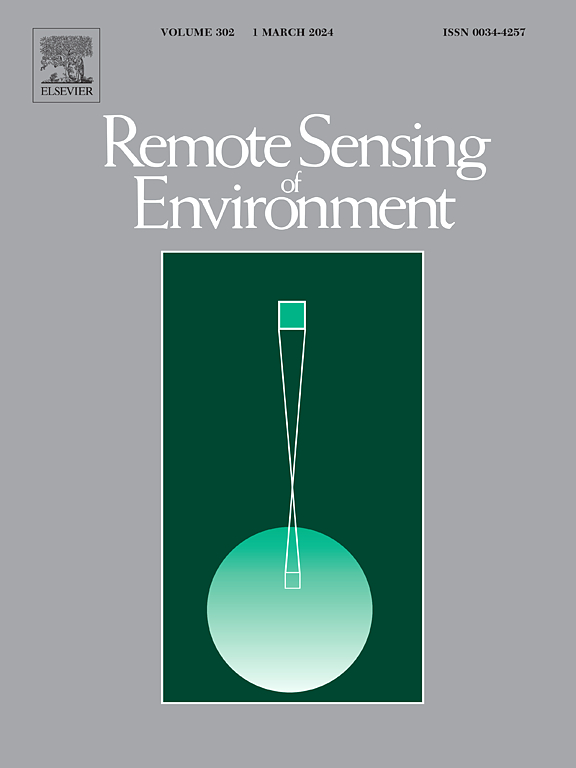The relationship between the ratio of far-red to red leaf SIF and leaf chlorophyll content: Theoretical derivation and experimental validation
IF 11.1
1区 地球科学
Q1 ENVIRONMENTAL SCIENCES
引用次数: 0
Abstract
Leaf chlorophyll content (LCC) is an important indicator of photosynthetic capacity. Sun-induced chlorophyll fluorescence (SIF) is an optical signal emitted from the leaf interior, providing a unique technique for accurately estimating LCC. The far-red to red ratio of chlorophyll fluorescence (Fratio) has been used to empirically estimate LCC in some previous studies. While these studies support the use of the Fratio for LCC estimation, its theoretical underpinning remains less well-defined and its effectiveness across a wider range of scenarios remains unclear. In this study, we established the relationship between the Fratio and LCC using the light use efficiency (LUE)-based SIF model and spectral invariant radiative transfer theory. Firstly, the LUE-based SIF model demonstrates that the change in the leaf Fratio is controlled by the ratio of the fluorescence escape fraction (i.e., fesc from the photosystem to the leaf surface) at the corresponding bands. Secondly, a fesc modeling approach is presented using the spectral invariant theory and thus the fesc ratio is linked to LCC. Theoretical analysis shows that the Fratio has a strong correlation with LCC, which explains over 90 % of the variation in Fratio. Both experimental measurements and model simulations from a radiative transfer model Fluspect were used to validate the relationship between LCC and three Fratio (i.e., , and ), which were derived from the upward and downward SIF of leaves, as well as the total SIF observed from both sides. The Fluspect simulations were used to assess the sensitivity of the Fratio-LCC relationship to the leaf structure. Two types of experimental measurements, including the field measurements of three crops and the laboratory measurements of 20 tundra plants, were employed to examine the species dependence of the Fratio-LCC relationship. The performance of Fratio for LCC estimation was evaluated and compared with spectral indices and the PROSPECT model using the experimental measurements and leave-one-out cross-validation (LOOCV) approach. Both the Fluspect simulations and the experimental measurements indicate that the Fratio is strongly correlated with LCC for a wide range of leaf scenarios. The Fratio-LCC relationship remains relatively stable across different leaf structures and plant species, since the relationship is almost consistent. The LOOCV of experimental measurements shows that the Fratio provides promising and robust LCC estimates, with the performing the best. The outperforms spectral indices, reducing the RMSE for LCC estimation by 19.5 %–93.9 %. Furthermore, compared to the PROSPECT model, the Fratio achieves a reduction in RMSE by 30.4 %–77.8 %. These results demonstrate that the Fratio is effective for estimating LCC of diverse plant species. This study advances our understanding of the relationship between the Fratio and LCC, supporting the use of SIF signals for remote sensing of LCC.
远红外线与红叶 SIF 之比与叶绿素含量之间的关系:理论推导与实验验证
叶片叶绿素含量(LCC)是植物光合能力的重要指标。太阳诱导的叶绿素荧光(SIF)是一种从叶片内部发出的光信号,为准确估计LCC提供了一种独特的技术。在以往的一些研究中,叶绿素荧光的远红红比(ratio)被用于经验估计LCC。虽然这些研究支持使用比率进行LCC估算,但其理论基础仍然不太明确,其在更大范围情景中的有效性仍然不清楚。在本研究中,我们利用基于光利用效率(LUE)的SIF模型和光谱不变辐射传输理论建立了比率与LCC之间的关系。首先,基于lue的SIF模型表明,叶片比率的变化是由相应波段的荧光逃逸分数(即从光系统到叶片表面的fesc)的比值控制的。其次,利用谱不变性理论提出了fesc建模方法,从而将fesc比率与LCC联系起来。理论分析表明,该比率与LCC有很强的相关性,LCC可以解释90%以上的比率变化。利用实验测量和辐射传输模型Fluspect的模型模拟,验证了LCC与叶片向上和向下SIF的三个比率(即Fratio↑、Fratio↓和Fratiotot)以及两侧观测到的总SIF之间的关系。使用Fluspect模拟来评估比率- lcc关系对叶片结构的敏感性。采用三种作物的田间测量和20种冻土带植物的室内测量两种类型的实验测量来检验比值- lcc关系的物种依赖性。利用实验测量和留一交叉验证(LOOCV)方法,评估了ratio估计LCC的性能,并将其与光谱指数和PROSPECT模型进行了比较。Fluspect模拟和实验测量都表明,对于广泛的叶片场景,该比率与LCC密切相关。在不同的叶片结构和不同的植物物种中,分数- lcc关系保持相对稳定,因为关系几乎是一致的。实验测量的LOOCV表明,Fratiotot提供了有前途的鲁棒LCC估计,其中Fratiotot表现最好。该方法优于光谱指数,将LCC估计的RMSE降低了19.5% - 93.9%。此外,与PROSPECT模型相比,该比率使均方根误差降低了30.4% - 77.8%。这些结果表明,该比值可以有效地估算不同植物物种的LCC。本研究促进了我们对该比值与LCC之间关系的理解,为使用SIF信号进行LCC遥感提供了支持。
本文章由计算机程序翻译,如有差异,请以英文原文为准。
求助全文
约1分钟内获得全文
求助全文
来源期刊

Remote Sensing of Environment
环境科学-成像科学与照相技术
CiteScore
25.10
自引率
8.90%
发文量
455
审稿时长
53 days
期刊介绍:
Remote Sensing of Environment (RSE) serves the Earth observation community by disseminating results on the theory, science, applications, and technology that contribute to advancing the field of remote sensing. With a thoroughly interdisciplinary approach, RSE encompasses terrestrial, oceanic, and atmospheric sensing.
The journal emphasizes biophysical and quantitative approaches to remote sensing at local to global scales, covering a diverse range of applications and techniques.
RSE serves as a vital platform for the exchange of knowledge and advancements in the dynamic field of remote sensing.
 求助内容:
求助内容: 应助结果提醒方式:
应助结果提醒方式:


